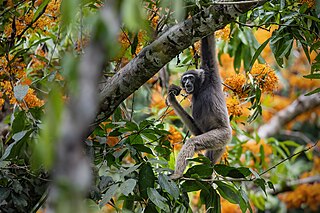Salomon Müller was a German naturalist. He was born in Heidelberg, and died in Freiburg im Breisgau.

Baron Sir Ferdinand Jacob Heinrich von Mueller, was a German-Australian physician, geographer, and most notably, a botanist. He was appointed government botanist for the then colony of Victoria (Australia) by Governor Charles La Trobe in 1853, and later director of the Royal Botanic Gardens, Melbourne. He also founded the National Herbarium of Victoria. He named many Australian plants.

Müller's gibbon, also known as the southern grey gibbon, is a primate in the gibbon family, Hylobatidae.

Friedrich "Fritz" Müller was a Swiss doctor, zoologist, and herpetologist.
Sclerocytes are specialised cells that secrete the mineralized structures in the body wall of some invertebrates.

Maurolicus muelleri, commonly referred to as Mueller's pearlside,Mueller's bristle-mouth fish, or the silvery lightfish, is a marine hatchetfish in the genus Maurolicus, found in deep tropical, subtropical and temperate waters of the Pacific Ocean and the Atlantic Ocean, from the surface to depths of 1,500 metres (4,900 ft). It can grow to a maximum total length of 8 centimetres (3.1 in).

Müller's giant Sunda rat is a species of rodent in the family Muridae. It is found in Indonesia, Malaysia, Myanmar, the Philippines, and Thailand.

Callitris muelleri is a species of conifer in the family Cupressaceae. It is found only in New South Wales, Australia.

Micrelaps muelleri is a species of mildly venomous rear-fanged snake in the family Lamprophiidae. The species is endemic to the Middle East.

The brown dorcopsis, also known as the brown forest wallaby, is a species of marsupial in the family Macropodidae. It is endemic to the lowlands of West New Guinea and the nearby Indonesian islands in West Papua of Misool, Salawati, and Yapen.

Agonum muelleri is a species of ground beetle native to the Palearctic, the Nearctic and the Near East. In Europe, it is found in Albania, the Azores, Baltic states, Belarus, Benelux, Great Britain including the Isle of Man, Northern Ireland, mainland Portugal, Russia, Sardinia, Sicily (doubtful), mainland Spain, Ukraine, Scandinavia, Slovenia, Croatia, Serbia, Montenegro, Bosnia-Herzegovina, and North Macedonia, and Central Europe.

Amphimedon queenslandica is a sponge native to the Great Barrier Reef. Its genome has been sequenced. It has been the subject of various studies on the evolution of metazoan development.

Eryx muelleri, known commonly as Müller's sand boa or the Saharan sand boa, is a species of snake in the family Boidae. The species is endemic to Africa. They are kept fairly regularly in the pet industry due to their docile nature and easy care.

Persoonia muelleri, commonly known as Mueller’s geebung, is a shrub endemic to Tasmania. It forms a shrub in open areas of wet forests in the west and northeast of the state. It is occasionally confused with P. gunnii though it has larger flowers and longer, straighter leaves.
Hyaloklossia is a genus of parasitic alveolates in the phylum Apicomplexa. Only one species in this genus is currently recognised - Hyaloklossia lieberkuehni.

Ophiactis is a genus of brittle stars (Ophiuroidea).

Azteca muelleri is a species of ant in the genus Azteca. Described by the Italian entomologist Carlo Emery in 1893, the species is native to Central and South America. It lives in colonies in the hollow trunk and branches of Cecropia trees. The specific name muelleri was given in honour of a German biologist Fritz Müller, who discovered that the small bodies at the petiole-bases of Cecropia are food bodies.
Gert Wörheide is a German marine biologist who works mainly on marine invertebrates. He earned his doctorate in geobiology from Georg-August-Universität, following this with a post-doctorate at Queensland Museum (1998-2002), where he worked with John Hooper on sponges, a collaboration which continues.

Ephydatia fluviatilis is a species of Ephydatia.
Ephydatia is a genus of sponges belonging to the family Spongillidae.














